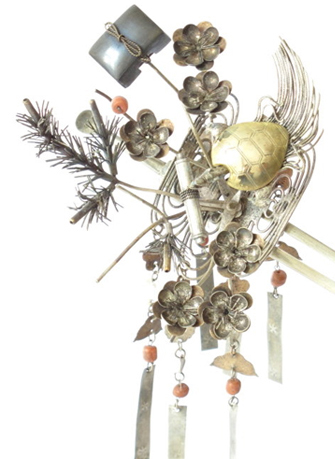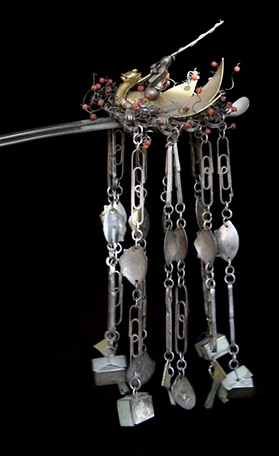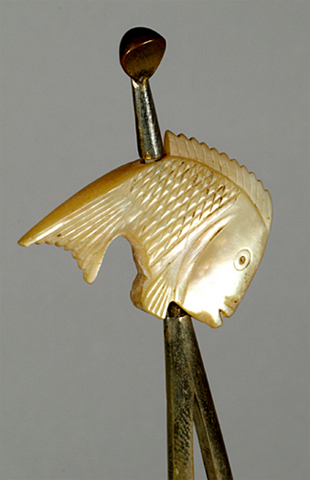The kanzashi’s original purpose was a charm against evil spirits. The tradition began as early as 1000 BC to 300 AD, in Japan’s Jomon Era. Decorating them with flowers invited deities. The art captured the Japanese cultural imagination in the Edo era (1603 – 1867), when criminal activity increased. This initiated laws that prohibited people from going out in hats or head coverings, so hairdressing once again came to the forefront of Japanese fashion.
There are many different kinds of kanzashi:
- Mimikaki: an ear pick on the end.
- Tama: decorated with a single coral or jade ball. However now, many materials are used.
- Hirauchi: a flat silver circle decorated with flowers or symbols
- Hana: strings of dangling flowers, worn by geishas
- Bira Bira: fans with long dangling chains, which have ornaments at the bottom
The most interesting ones have unique elements, either as a single decoration or a set of concepts. I’d like to feature three today, one each, from my collection, The Miriam Slater Collection, and The Creative Museum.
My bridal kanzashi is decorated with Mino-Kame — a straw raincoat, which used to be worn before the invention of textiles; a tortoise and pine boughs for longevity; a scroll of wisdom; a treasure box; and flowers, indicating nobility.

Miriam’s kanzashi is unique. A man with a fishing pole sits on a curved leaf structure, surrounded by dangling chains.

Finally, the Creative Museum has one I absolutely love: a gold fish, whose face looks almost human.


My, the ordinary stick-in-the-hair has come a long way with these beautiful kanzashi.
Yes, and there are modern hair-stick makers, too. Their ideas are completely different. It’s really amazing what different minds, historical periods, and cultures can do to something as simple as a stick. :-)
What an interesting article and gorgeous items!
Where did you find these details about the different kinds of kanzashi? From a Japanese people or from an informative book on this topic? In this case, can you give me, please, its title? I would like to learn more about all these complex Japanese ornaments. Nearly all my books are in Japanese idiom and I cannot understand!
Thank you.
http://www.kyopro.kufs.ac.jp/dp/dp01.nsf/b7eb328e75d9627a49256feb00103b33/4269824e8da4cc174925760000113593!OpenDocument
:-)
Not only do I adore your beautiful combs, but the history behind them is wonderful. I am a kind of history buff and enjoy learning little hidden facts. I had never done a historical search on hair combs before.
This has nothing to do with hair or combs, but have you ever heard of inro purses and netsuke fasteners? These are the types of things I research when working on my historical, fantasy adventures set in feudal Japan.
BTW, my novel, Legend of the Tengu Prince,is now available at Smashwords. This is the link to my novel’s blog. http://legendofthetenguprince.wordpress.com/
Ledia, beautiful novel. Thanks so much for sharing it. Yes, I have heard of inro purses with their netsuke fasteners, but when you delve into one object, every other art form seems like an ocean.